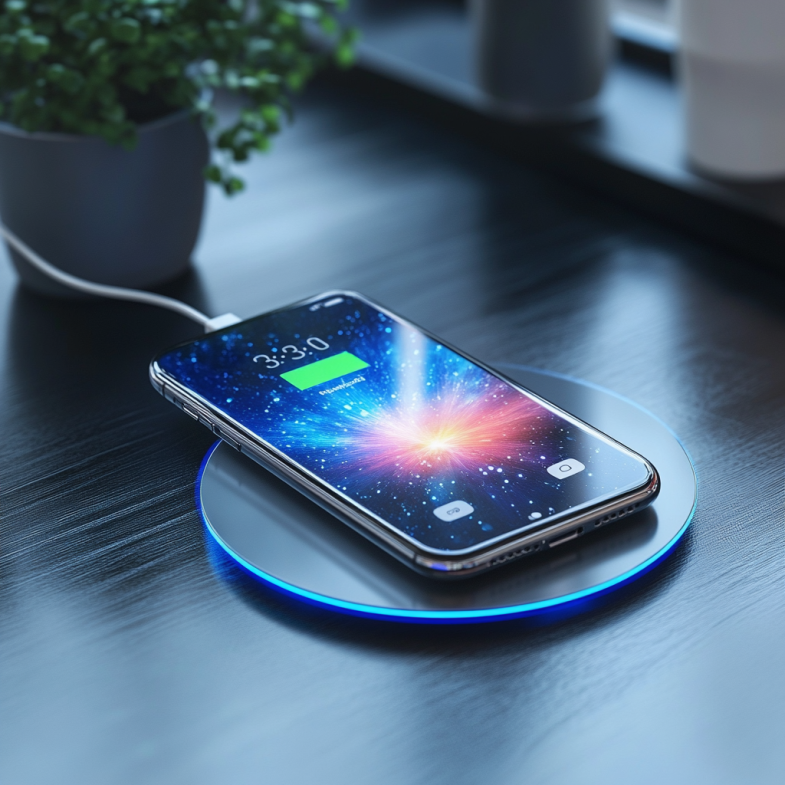With the development of technology, more and more devices are becoming wireless. This applies not only to communication, but also to power supply. Wireless charging has already become popular among users of smartphones and other portable devices. However, despite significant progress, this technology is not without its drawbacks. In this article, we will look at how wireless charging works, what capabilities it has, and what problems still need to be solved.
Chapter 1: How Wireless Chargers Work
Inductive Power Transfer
Most modern wireless chargers use inductive power transfer. The main component of such a system is an inductive coil, which is located in the charger (transmitter) and in the device itself (receiver). When an electric current passes through the transmitter coil, it creates an alternating magnetic field. This magnetic field induces a current in the receiver coil, which is then converted into electricity to charge the device.
This process is based on Faraday’s law, which states that a changing magnetic field can induce an electric current in a conductor. Inductive power transfer is used in standards such as Qi and Powermat , which are supported by most modern smartphones and other portable devices.
Resonant Power Transfer
Another method of wireless power transfer is resonant power transfer. This method also uses inductive coils, but with the addition of resonant frequencies. In resonant power transfer, both coils (the transmitter and receiver) are tuned to the same resonant frequency, allowing for greater efficiency in power transfer over longer distances. This method is especially useful for charging multiple devices at once or for charging devices at a greater distance from the transmitter.
Microwave Power Transfer
Microwave power transfer is a more experimental method that uses microwaves to transmit power over longer distances. In this case, the transmitter generates microwaves, which are then focused on the receiver using special antennas. The advantage of this method is that it can transfer energy over long distances, but its efficiency is still significantly lower than that of induction and resonant transmission.
Chapter 2: Wireless Charging Capabilities
Ease of Use
One of the main advantages of wireless charging is ease of use. Users no longer need to fiddle with wires and connectors; they can simply place the device on the charging station. This is especially useful for people who frequently use portable devices such as smartphones, tablets, and wearables.
Safety and Durability
Wireless charging can also be safer and more durable than traditional wired charging. Since there is no need to plug and unplug cables, the risk of damage to connectors and ports is minimal. In addition, many wireless chargers have protection against overheating, short circuits, and other potential hazards.
Advanced Features
As technology advances, wireless charging can offer new capabilities. For example, some companies are already working on systems that allow charging multiple devices simultaneously and charging devices at a greater distance from the transmitter. This opens up new horizons for the use of wireless charging in homes, offices, and public places.
Chapter 3: Issues and Challenges
Power Transfer Efficiency
One of the main problems with wireless charging is its comparatively low power transfer efficiency. Compared to wired charging, wireless systems lose some energy in the form of heat and radiation. This leads to longer charging times and increased energy consumption. To solve this problem, it is necessary to develop more efficient power transfer methods and improved materials for inductive coils.
Distance and Orientation
Another problem is the limited range and the need for precise placement of the device on the charging station. Most modern wireless chargers require the device to be in close proximity to the transmitter and correctly oriented relative to the coil. This limits usability and makes it impossible to charge devices at a long distance or while moving. To solve this problem, it is necessary to develop systems that can transmit energy over longer distances and with less dependence on the orientation of the device.
Standardization and compatibility
Standardization and compatibility also remain important issues for the development of wireless charging. There are many different standards and technologies on the market, such as Qi, Powermat and others, which are not always compatible with each other. This creates difficulties for users who comet to choose between different chargers and accessories. To solve this problem, it is necessary to develop uniform standards and ensure interoperability of different systems.
Chapter 4: The Future of Wireless Charging
Improving Efficiency
In the future, we can expect significant improvements in the efficiency of wireless charging due to the development of new materials and technologies. For example, the use of graphene and other highly conductive materials can significantly improve the efficiency of inductive coils. In addition, the development of resonant energy transfer will increase the distance and reduce dependence on the orientation of the device.
Charging at a distance
One of the most promising areas of development is charging at a distance. Companies such as Energous and Ossia are already working on creating systems that can transmit energy over distances of up to several meters. These systems can be used to charge multiple devices at the same time, which will make wireless charging even more convenient and versatile.
Integration into the environment
In the future, wireless charging can be integrated into the environment, such as furniture, walls, and even clothing. This will allow devices to be charged without the need for specially equipped charging stations. For example, tables and chairs can be equipped with built-in chargers that will automatically charge your gadgets when you are nearby.
Wireless charging has already become an important part of our lives, offering convenience and safety of use. However, despite significant progress, this technology is not without its drawbacks and requires further development. Improving efficiency, increasing range, and solving compatibility issues are key tasks for the future of wireless charging. It is important to remember that the implementation of these technologies should be aimed at the benefit of society and take into account the interests of all its members.






